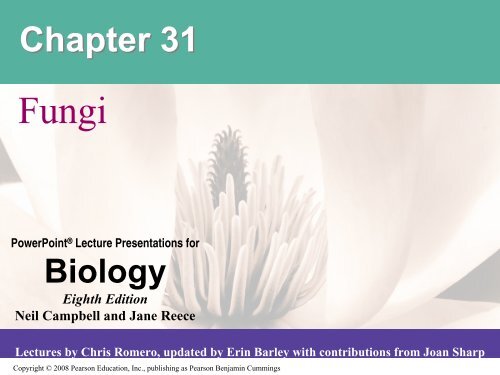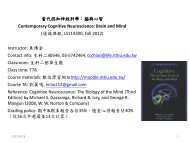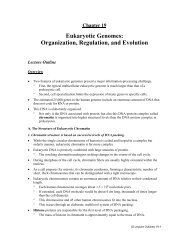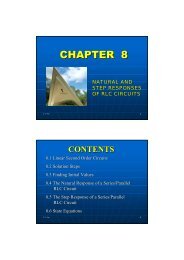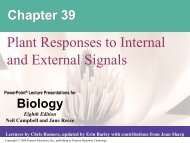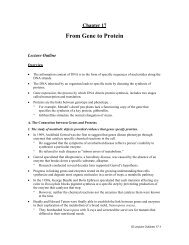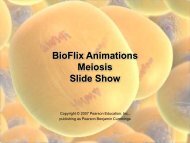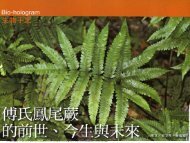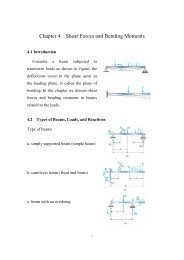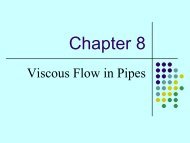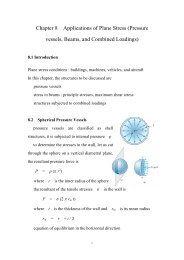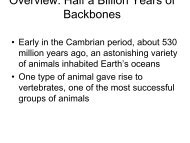hyphae
hyphae
hyphae
Create successful ePaper yourself
Turn your PDF publications into a flip-book with our unique Google optimized e-Paper software.
Chapter 31FungiPowerPoint ® Lecture Presentations forBiologyEighth EditionNeil Campbell and Jane ReeceLectures by Chris Romero, updated by Erin Barley with contributions from Joan SharpCopyright © 2008 Pearson Education, Inc., publishing as Pearson Benjamin Cummings
Fig. 31-1
Concept 31.1: Fungi are heterotrophs that feed byabsorption• Despite their diversity, fungi share key traits,most importantly the way in which they derivenutritionCopyright © 2008 Pearson Education, Inc., publishing as Pearson Benjamin Cummings
Nutrition and Ecology• Fungi are heterotrophs and absorb nutrientsfrom outside of their body• Fungi use enzymes to break down a largevariety of complex molecules into smallerorganic compounds• The versatility of these enzymes contributes tofungi’s ecological successCopyright © 2008 Pearson Education, Inc., publishing as Pearson Benjamin Cummings
• Fungi exhibit diverse lifestyles:– Decomposers– Parasites– MutualistsCopyright © 2008 Pearson Education, Inc., publishing as Pearson Benjamin Cummings
Body Structure• The most common body structures aremulticellular filaments and single cells (yeasts)• Some species grow as either filaments oryeasts; others grow as bothAnimation: Fungal Reproduction and NutritionCopyright © 2008 Pearson Education, Inc., publishing as Pearson Benjamin Cummings
Fungal Morphology• The morphology of multicellular fungi enhancestheir ability to absorb nutrients• Fungi consist of mycelia, networks ofbranched <strong>hyphae</strong> adapted for absorption• Most fungi have cell walls made of chitinCopyright © 2008 Pearson Education, Inc., publishing as Pearson Benjamin Cummings
Fig. 31-2Reproductive structureHyphaeSpore-producingstructures20 µmMycelium
• Some fungi have <strong>hyphae</strong> divided into cells bysepta, with pores allowing cell-to-cellmovement of organelles• Coenocytic fungi lack septaCopyright © 2008 Pearson Education, Inc., publishing as Pearson Benjamin Cummings
Fig. 31-3NucleiCell wallCell wallPoreSeptumNuclei(a) Septate hypha(b) Coenocytic hypha
Specialized Hyphae in Mycorrhizal Fungi• Some unique fungi have specialized <strong>hyphae</strong>called haustoria that allow them to penetratethe tissues of their hostCopyright © 2008 Pearson Education, Inc., publishing as Pearson Benjamin Cummings
Fig. 31-4NematodeHyphae25 µm(a) Hyphae adapted for trapping and killing preyFungal hyphaPlantcellwallPlant cell(b) HaustoriaHaustoriumPlant cellplasmamembrane
Fig. 31-4aNematodeHyphae25 µm(a) Hyphae adapted for trapping and killing prey
Fig. 31-4bFungal hyphaPlantcellwallPlant cell(b) HaustoriaHaustoriumPlant cellplasmamembrane
• Mycorrhizae are mutually beneficialrelationships between fungi and plant roots• Ectomycorrhizal fungi form sheaths of<strong>hyphae</strong> over a root and also grow into theextracellular spaces of the root cortex• Arbuscular mycorrhizal fungi extend <strong>hyphae</strong>through the cell walls of root cells and intotubes formed by invagination of the root cellmembraneCopyright © 2008 Pearson Education, Inc., publishing as Pearson Benjamin Cummings
Concept 31.2: Fungi produce spores throughsexual or asexual life cycles• Fungi propagate themselves by producing vastnumbers of spores, either sexually or asexually• Fungi can produce spores from different typesof life cyclesCopyright © 2008 Pearson Education, Inc., publishing as Pearson Benjamin Cummings
Fig. 31-5-1KeyHaploid (n)Heterokaryotic(unfused nuclei fromdifferent parents)Diploid (2n)Spore-producingstructuresSporesASEXUALREPRODUCTIONMyceliumGERMINATION
Fig. 31-5-2KeyHaploid (n)Heterokaryotic(unfused nuclei fromdifferent parents)Diploid (2n)SporesSpore-producingstructuresASEXUALREPRODUCTIONPLASMOGAMY(fusion of cytoplasm)MyceliumHeterokaryoticstageKARYOGAMY(fusion of nuclei)ZygoteSEXUALREPRODUCTIONGERMINATION
Fig. 31-5-3KeyHaploid (n)Heterokaryotic(unfused nuclei fromdifferent parents)Diploid (2n)SporesSpore-producingstructuresASEXUALREPRODUCTIONPLASMOGAMY(fusion of cytoplasm)MyceliumHeterokaryoticstageKARYOGAMY(fusion of nuclei)ZygoteSEXUALREPRODUCTIONGERMINATIONGERMINATIONMEIOSISSpores
Sexual Reproduction• Fungal nuclei are normally haploid, with theexception of transient diploid stages formedduring the sexual life cycles• Sexual reproduction requires the fusion of<strong>hyphae</strong> from different mating types• Fungi use sexual signaling molecules calledpheromones to communicate their mating typeCopyright © 2008 Pearson Education, Inc., publishing as Pearson Benjamin Cummings
• Plasmogamy is the union of two parentmycelia• In most fungi, the haploid nuclei from eachparent do not fuse right away; they coexist inthe mycelium, called a heterokaryon• In some fungi, the haploid nuclei pair off two toa cell; such a mycelium is said to be dikaryoticCopyright © 2008 Pearson Education, Inc., publishing as Pearson Benjamin Cummings
• Hours, days, or even centuries may passbefore the occurrence of karyogamy, nuclearfusion• During karyogamy, the haploid nuclei fuse,producing diploid cells• The diploid phase is short-lived and undergoesmeiosis, producing haploid sporesCopyright © 2008 Pearson Education, Inc., publishing as Pearson Benjamin Cummings
Asexual Reproduction• In addition to sexual reproduction, many fungican reproduce asexually• Molds produce haploid spores by mitosis andform visible myceliaCopyright © 2008 Pearson Education, Inc., publishing as Pearson Benjamin Cummings
Fig. 31-62.5 µm
• Other fungi that can reproduce asexually areyeasts, which inhabit moist environments• Instead of producing spores, yeasts reproduceasexually by simple cell division and thepinching of “bud cells” from a parent cellCopyright © 2008 Pearson Education, Inc., publishing as Pearson Benjamin Cummings
Fig. 31-710 µmParentcellBud
• Many molds and yeasts have no known sexualstage• Mycologists have traditionally called thesedeuteromycetes, or imperfect fungiCopyright © 2008 Pearson Education, Inc., publishing as Pearson Benjamin Cummings
Concept 31.3: The ancestor of fungi was anaquatic, single-celled, flagellated protist• Fungi and animals are more closely related toeach other than they are to plants or othereukaryotesCopyright © 2008 Pearson Education, Inc., publishing as Pearson Benjamin Cummings
The Origin of Fungi• Fungi, animals, and their protistan relativesform the opisthokonts cladeCopyright © 2008 Pearson Education, Inc., publishing as Pearson Benjamin Cummings
Fig. 31-8FungiUNICELLULAR,FLAGELLATEDANCESTORAnimals (and their closeprotistan relatives)NucleariidsChytridsOpisthokontsOther fungi
• DNA evidence suggests that fungi are mostclosely related to unicellular nucleariids whileanimals are most closely related to unicellularchoanoflagellates• This suggests that fungi and animals evolvedfrom a common flagellated unicellular ancestorand multicellularity arose separately in the twogroups• The oldest undisputed fossils of fungi are onlyabout 460 million years oldCopyright © 2008 Pearson Education, Inc., publishing as Pearson Benjamin Cummings
Fig. 31-950 µm
Are Microsporidia Closely Related to Fungi?• Microsporidia are unicellular parasites ofanimals and protists• They have tiny organelles derived frommitochondria but not conventional mitochondria• Molecular comparisons indicate they may beclosely related to fungiCopyright © 2008 Pearson Education, Inc., publishing as Pearson Benjamin Cummings
Fig. 31-1010 µmHost cellnucleusDevelopingmicrosporidianSpore
The Move to Land• Fungi were among the earliest colonizers ofland and probably formed mutualisticrelationships with early land plantsCopyright © 2008 Pearson Education, Inc., publishing as Pearson Benjamin Cummings
Concept 31.4: Fungi have radiated into a diverseset of lineages• Molecular analyses have helped clarifyevolutionary relationships among fungal groups,although areas of uncertainty remainCopyright © 2008 Pearson Education, Inc., publishing as Pearson Benjamin Cummings
Fig. 31-11Hyphae 25 µmChytrids (1,000 species)Zygomycetes (1,000 species)Fungal hyphaGlomeromycetes (160 species)Ascomycetes (65,000 species)Basidiomycetes (30,000 species)
Fig. 31-11aHyphae 25 µmChytrids (1,000 species)
Fig. 31-11bZygomycetes (1,000 species)
Fig. 31-11cFungal hyphaGlomeromycetes (160 species)
Fig. 31-11dAscomycetes (65,000 species)
Fig. 31-11eBasidiomycetes (30,000 species)
Chytrids• Chytrids (phylum Chytridiomycota) are foundin freshwater and terrestrial habitats• They can be decomposers, parasites, ormutualists• Molecular evidence supports the hypothesisthat chytrids diverged early in fungal evolution• Chytrids are unique among fungi in havingflagellated spores, called zoosporesVideo: Allomyces Zoospore ReleaseVideo: Phlyctochytrium Zoospore ReleaseCopyright © 2008 Pearson Education, Inc., publishing as Pearson Benjamin Cummings
Fig. 31-UN1ChytridsZygomycetesGlomeromycetesAscomycetesBasidiomycetes
Fig. 31-12Flagellum4 µm
• Until recently, systematists thought that fungilost flagella only once in their evolutionaryhistory• Molecular data indicate that some “chytrids”are actually more closely related to anotherfungal group, the zygomycetes; chytrids are aparaphyletic groupCopyright © 2008 Pearson Education, Inc., publishing as Pearson Benjamin Cummings
Zygomycetes• The zygomycetes (phylum Zygomycota)exhibit great diversity of life histories• They include fast-growing molds, parasites,and commensal symbionts• The zygomycetes are named for their sexuallyproduced zygosporangia• Zygosporangia, which are resistant to freezingand drying, can survive unfavorable conditionsCopyright © 2008 Pearson Education, Inc., publishing as Pearson Benjamin Cummings
Fig. 31-UN2ChytridsZygomycetesGlomeromycetesAscomycetesBasidiomycetes
• The life cycle of black bread mold (Rhizopusstolonifer) is fairly typical of the phylumCopyright © 2008 Pearson Education, Inc., publishing as Pearson Benjamin Cummings
Fig. 31-13-1KeyHaploid (n)Heterokaryotic (n + n)Diploid (2n)Rhizopusgrowingon breadMatingtype (+)Matingtype (–)Gametangia withhaploid nucleiSEXUALREPRODUCTIONPLASMOGAMYYoungzygosporangium(heterokaryotic)
Fig. 31-13-2KeyHaploid (n)Heterokaryotic (n + n)Diploid (2n)PLASMOGAMYRhizopusgrowingon breadMatingtype (+)Matingtype (–)Gametangia withhaploid nucleiSEXUALREPRODUCTIONYoungzygosporangium(heterokaryotic)100 µmZygosporangiumKARYOGAMYDiploidnuclei
Fig. 31-13-3KeyHaploid (n)Heterokaryotic (n + n)Diploid (2n)PLASMOGAMYRhizopusgrowingon breadMatingtype (+)Matingtype (–)Gametangia withhaploid nucleiSEXUALREPRODUCTIONYoungzygosporangium(heterokaryotic)100 µmDispersal andgerminationSporesSporangiumMEIOSISKARYOGAMYDiploidnucleiZygosporangium
Fig. 31-13-4KeyHaploid (n)Heterokaryotic (n + n)Diploid (2n)PLASMOGAMYRhizopusgrowingon breadMatingtype (+)Matingtype (–)Gametangia withhaploid nucleiSEXUALREPRODUCTIONYoungzygosporangium(heterokaryotic)100 µmSporangiaDispersal andgerminationKARYOGAMYZygosporangiumSporesASEXUALREPRODUCTIONSporangiumMEIOSISDiploidnucleiDispersal andgermination50 µmMycelium
• Some zygomycetes, such as Pilobolus, canactually “aim” their sporangia toward conditionsassociated with good food sourcesCopyright © 2008 Pearson Education, Inc., publishing as Pearson Benjamin Cummings
Fig. 31-140.5 mm
Glomeromycetes• The glomeromycetes (phylumGlomeromycota) were once consideredzygomycetes• They are now classified in a separate clade• Glomeromycetes form arbuscular mycorrhizaeCopyright © 2008 Pearson Education, Inc., publishing as Pearson Benjamin Cummings
Fig. 31-UN3ChytridsZygomycetesGlomeromycetesAscomycetesBasidiomycetes
Fig. 31-152.5 µm
Ascomycetes• Ascomycetes (phylum Ascomycota) live inmarine, freshwater, and terrestrial habitats• The phylum is defined by production of sexualspores in saclike asci, usually contained infruiting bodies called ascocarps• Ascomycetes are commonly called sac fungi• Ascomycetes vary in size and complexity fromunicellular yeasts to elaborate cup fungi andmorelsCopyright © 2008 Pearson Education, Inc., publishing as Pearson Benjamin Cummings
Fig. 31-UN4ChytridsZygomycetesGlomeromycetesAscomycetesBasidiomycetes
Fig. 31-16Morchella esculenta,the tasty morelTuber melanosporum, a truffle
Fig. 31-16aMorchella esculenta,the tasty morel
Fig. 31-16bTuber melanosporum, a truffle
• Ascomycetes include plant pathogens,decomposers, and symbionts• Ascomycetes reproduce asexually byenormous numbers of asexual spores calledconidia• Conidia are not formed inside sporangia; theyare produced asexually at the tips ofspecialized <strong>hyphae</strong> called conidiophores• Neurospora is a model organism with a wellstudiedgenomeCopyright © 2008 Pearson Education, Inc., publishing as Pearson Benjamin Cummings
Fig. 31-17-1Haploid spores (conidia)DispersalASEXUALREPRODUCTIONGerminationHyphaKeyHaploid (n)Dikaryotic (n + n)Diploid (2n)ConidiophoreMycelium
Fig. 31-17-2Haploid spores (conidia)ConidiophoreDispersalASEXUALREPRODUCTIONGerminationHyphaConidia;mating type (–)Matingtype (+)PLASMOGAMYKeyHaploid (n)Dikaryotic (n + n)Diploid (2n)Ascus(dikaryotic)MyceliumMyceliaDikaryotic<strong>hyphae</strong>SEXUALREPRODUCTION
Fig. 31-17-3Haploid spores (conidia)ConidiophoreDispersalASEXUALREPRODUCTIONGerminationHyphaConidia;mating type (–)Matingtype (+)PLASMOGAMYKeyHaploid (n)Dikaryotic (n + n)Diploid (2n)Ascus(dikaryotic)MyceliumMyceliaDikaryotic<strong>hyphae</strong>SEXUALREPRODUCTIONKARYOGAMYDiploid nucleus(zygote)
Fig. 31-17-4Haploid spores (conidia)ConidiophoreDispersalASEXUALREPRODUCTIONGerminationHyphaConidia;mating type (–)Matingtype (+)PLASMOGAMYKeyHaploid (n)Dikaryotic (n + n)Diploid (2n)Ascus(dikaryotic)MyceliumGerminationAscocarpMyceliaDispersalAsciDikaryotic<strong>hyphae</strong>SEXUALREPRODUCTIONEightascosporesKARYOGAMYDiploid nucleus(zygote)FourhaploidnucleiMEIOSIS
Basidiomycetes• Basidomycetes (phylum Basidiomycota)include mushrooms, puffballs, and shelf fungi,mutualists, and plant parasites• The phylum is defined by a clublike structurecalled a basidium, a transient diploid stage inthe life cycle• The basidiomycetes are also called club fungiCopyright © 2008 Pearson Education, Inc., publishing as Pearson Benjamin Cummings
Fig. 31-UN5ChytridsZygomycetesGlomeromycetesAscomycetesBasidiomycetes
Fig. 31-18Maiden veil fungus(Dictyphora), afungus with anodor like rottingmeatPuffballs emittingsporesShelf fungi, importantdecomposers of wood
Fig. 31-18aMaiden veil fungus(Dictyphora), afungus with an odorlike rotting meat
Fig. 31-18bPuffballs emittingspores
Fig. 31-18cShelf fungi, importantdecomposers of wood
• The life cycle of a basidiomycete usuallyincludes a long-lived dikaryotic mycelium• In response to environmental stimuli, themycelium reproduces sexually by producingelaborate fruiting bodies call basidiocarps• Mushrooms are examples of basidiocarps• The numerous basidia in a basidiocarp aresources of sexual spores called basidiosporesCopyright © 2008 Pearson Education, Inc., publishing as Pearson Benjamin Cummings
Fig. 31-19-1Haploid myceliaPLASMOGAMYDikaryotic myceliumMatingtype (–)Matingtype (+)SEXUALREPRODUCTIONKeyHaploid (n)Dikaryotic (n+n)Diploid (2n)
Fig. 31-19-2Haploid myceliaPLASMOGAMYDikaryotic myceliumMatingtype (–)Matingtype (+)Gills linedwith basidiaSEXUALREPRODUCTIONBasidiocarp(n+n)Basidia(n+n)KeyHaploid (n)Dikaryotic (n+n)Diploid (2n)
Fig. 31-19-3Haploid myceliaPLASMOGAMYDikaryotic myceliumMatingtype (–)Matingtype (+)Gills linedwith basidiaSEXUALREPRODUCTIONBasidiocarp(n+n)Basidia(n+n)KARYOGAMYDiploidnucleiKeyHaploid (n)Dikaryotic (n+n)Diploid (2n)
Fig. 31-19-4Haploid myceliaPLASMOGAMYDikaryotic myceliumMatingtype (–)HaploidmyceliaMatingtype (+)SEXUALREPRODUCTIONGills linedwith basidiaBasidiocarp(n+n)BasidiumDispersal andgerminationBasidiospores(n)Basidium withfour basidiosporesBasidium containingfour haploid nucleiMEIOSISBasidia(n+n)KARYOGAMYKey1 µmBasidiosporeDiploidnucleiHaploid (n)Dikaryotic (n+n)Diploid (2n)
Fig. 31-20
Concept 31.5: Fungi play key roles in nutrientcycling, ecological interactions, and human welfare• Fungi interact with other organisms in manywaysCopyright © 2008 Pearson Education, Inc., publishing as Pearson Benjamin Cummings
Fungi as Decomposers• Fungi are efficient decomposers• They perform essential recycling of chemicalelements between the living and nonlivingworldCopyright © 2008 Pearson Education, Inc., publishing as Pearson Benjamin Cummings
Fungi as Mutualists• Fungi form mutualistic relationships with plants,algae, cyanobacteria, and animals• All of these relationships have profoundecological effectsCopyright © 2008 Pearson Education, Inc., publishing as Pearson Benjamin Cummings
Fungus-Plant Mutualisms• Mycorrhizae are enormously important innatural ecosystems and agriculture• Plants harbor harmless symbiotic endophytesthat live inside leaves or other plant parts• Endophytes make toxins that deter herbivoresand defend against pathogensCopyright © 2008 Pearson Education, Inc., publishing as Pearson Benjamin Cummings
Fig. 31-21RESULTSEndophyte not present; pathogen present (E–P+)Both endophyte and pathogen present (E+P+)Leaf mortality (%)3020100E–P+E+P+Leaf area damaged (%)151050E–P+E+P+
Fungus-Animal Symbioses• Some fungi share their digestive services withanimals• These fungi help break down plant material inthe guts of cows and other grazing mammals• Many species of ants and termites use thedigestive power of fungi by raising them in“farms”Copyright © 2008 Pearson Education, Inc., publishing as Pearson Benjamin Cummings
Fig. 31-22
Lichens• A lichen is a symbiotic association between aphotosynthetic microorganism and a fungus inwhich millions of photosynthetic cells are heldin a mass of fungal <strong>hyphae</strong>Copyright © 2008 Pearson Education, Inc., publishing as Pearson Benjamin Cummings
Fig. 31-23A fruticose (shrublike) lichenCrustose(encrusting)lichensA foliose(leaflike)lichen
Fig. 31-23aA fruticose (shrublike) lichen
Fig. 31-23bCrustose(encrusting)lichens
Fig. 31-23cA foliose(leaflike)lichen
• The fungal component of a lichen is most oftenan ascomycete• Algae or cyanobacteria occupy an inner layerbelow the lichen surfaceCopyright © 2008 Pearson Education, Inc., publishing as Pearson Benjamin Cummings
Fig. 31-24Ascocarp of fungusFungal<strong>hyphae</strong>AlgallayerSorediaAlgal cellFungal <strong>hyphae</strong>20 µm
• The algae provide carbon compounds,cyanobacteria provide organic nitrogen, andfungi provide the environment for growth• The fungi of lichens can reproduce sexuallyand asexually• Asexual reproduction is by fragmentation or theformation of soredia, small clusters of <strong>hyphae</strong>with embedded algaeCopyright © 2008 Pearson Education, Inc., publishing as Pearson Benjamin Cummings
• Lichens are important pioneers on new rockand soil surfaces• Lichens are sensitive to pollution, and theirdeath can be a warning that air quality isdeterioratingCopyright © 2008 Pearson Education, Inc., publishing as Pearson Benjamin Cummings
Fungi as Pathogens• About 30% of known fungal species areparasites or pathogens, mostly on or in plants• Some fungi that attack food crops are toxic tohumans• Animals are much less susceptible to parasiticfungi than are plants• The general term for a fungal infection inanimals is mycosisCopyright © 2008 Pearson Education, Inc., publishing as Pearson Benjamin Cummings
Fig. 31-25(a) Corn smut on corn(b) Tar spot fungus onmaple leaves(c) Ergots on rye
Fig. 31-25a(a) Corn smut on corn
Fig. 31-25b(b) Tar spot fungus onmaple leaves
Fig. 31-25c(c) Ergots on rye
Practical Uses of Fungi• Humans eat many fungi and use others tomake cheeses, alcoholic beverages, and bread• Some fungi are used to produce antibiotics forthe treatment of bacterial infections, forexample the ascomycete Penicillium• Genetic research on fungi is leading toapplications in biotechnology– For example, insulin-like growth factor can beproduced in the fungus SaccharomycescerevisiaeCopyright © 2008 Pearson Education, Inc., publishing as Pearson Benjamin Cummings
Fig. 31-26StaphylococcusPenicilliumZone ofinhibitedgrowth
Fig. 31-UN6
Fig. 31-UN6a
Fig. 31-UN6b
Fig. 31-UN6c
Fig. 31-UN6d
Fig. 31-UN6e
Fig. 31-T1
You should now be able to:1. List the characteristics that distinguish fungifrom other multicellular kingdoms2. Distinguish between ectomycorrhizal andarbuscular mycorrhizal fungi3. Describe the processes of plasmogamy andkaryogamy4. Describe the evidence that multicellularityevolved independently in fungi and animalsCopyright © 2008 Pearson Education, Inc., publishing as Pearson Benjamin Cummings
5. Describe the life cycles of Rhizopus stoloniferand Neurospora crassa6. Distinguish among zygomycetes, ascomycetes,and basidiomycetes7. Describe some of the roles of fungi inecosystems, lichens, animal-fungi mutualisticsymbioses, food production, and medicine andas pathogensCopyright © 2008 Pearson Education, Inc., publishing as Pearson Benjamin Cummings


